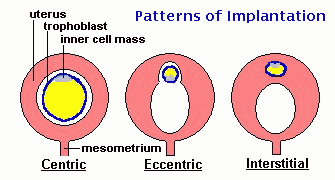
| Reproduction Index | Glossary |
|---|
 |
Attachment and Implantation |
Implantation is the first stage in development of the placenta. In most cases, implantation is preceeded by a close interaction of embryonic trophoblast and endometrial epithelial cells that is known as adhesion or attachment. Among other things, attachment involves a tight intertwining of microvilli on the maternal and embryonic cells. Following attachment, the blastocyst is no longer easily flushed from the lumen of the uterus. In species that carry multiple offspring, attachment is preceeded by a remarkably even spacing of embryos through the uterus. This process appears to result from uterine contractions and in some cases involves migration of embryos from one uterine horn to another (transuterine migration). The effect of implantation in all cases is to obtain very close apposition between embryonic and maternal tissues. There are, however, substantial differences among species in the process of implantation, particularly with regard to "invasiveness," or how much the embryo erodes into maternal tissue. In species like horses and pigs, attachment and implantation are essentially equivalent. In contrast, implantation in humans involves the embryo eroding deeply into the substance of the uterus. Many years ago, three fundamental patterns of implantation were described, based on the position the blastocyst assumes in the uterus:
 It has been difficult to attribute any particular advantage to the degree of invasiveness seen during implantation. One possible exception is that most species having highly invasive embryos have systems for prenatal transfer of antibodies from the mother to the fetus. For eccentric and interstitial implantations, what allows the embryo to invade the uterine substance? In some species it appears that the blastocyst is a passive participant, and the underlying endometrium degenerates. In other cases, including carnivores and probably humans, the embryo seems to be the aggressor and trophoblast actively invades into the endometrium. It's likely that both tissues participate to some degree. In species that undergo interstitial implantation, an interesting phenomenon called the decidual cell reaction occurs. This involves transformation of uterine stromal and endothelial cells into a tissue called the decidua, which becomes a substantial portion of the placenta and is expelled with the remainder of the placenta at the time of birth. The decidua is a prominent feature of the human placenta. It is clear that steroid hormones from the ovary are necessary to prepare the endometrium for implantation and for the process of implantation itself. In some species, progesterone alone appears to be adequate, while in others, estrogen and progesterone are required for implantation. In addition to the differences among species in the implantation process per se, there are also situations in which the timing of implantation varies. The usual case is for attachment and implantation to occur within a few days after the blastocyst reaches the uterus. In many animals, however, implantation can be delayed for substantial periods of time, during which the blastocyst enters a quiescent state called embryonic diapause. Delayed implantation seems to be a strategy used to regulate time of birth so that it occurs when environmental conditions are favorable. |
| Index of: Implantation and Development of the Placenta | |||
 |
Introduction and Index | Placental Structure and Classification |  |
Last updated on March 8, 2000 |
| Author: R. Bowen |
| Send comments via form or email to rbowen@colostate.edu |